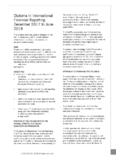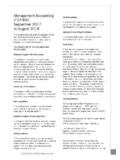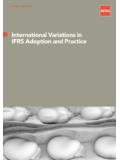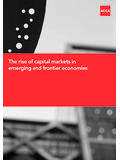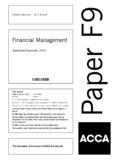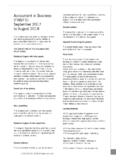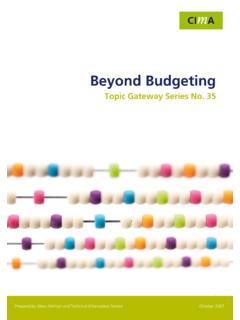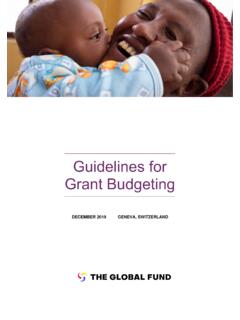Transcription of Planning, Budgeting and Forecasting
1 An eye on the futureA KPMG and ACCA Thought Leadership ReportPlanning, Budgeting and ForecastingCONTENTSA bout the research 4 Introduction 6 Executive summary 7 Create the right organisational culture and ways of working 8 Integrate the PBF process, leveraging high quality data 12 Deploy effective and scalable technology solutions 16 About the authors 22123AN EYE ON THE FUTURE | 3 ABOUT THE RESEARCHThis global report is the first of three pieces of research that have been jointly commissioned by ACCA and KPMG to assess how the Enterprise Performance management (EPM)* capability within Finance is providing the CFO with the appropriate people, processes and technology to support Planning, Budgeting and data used in the report is from a survey which was conducted between 17th April 2015 and 11th May 2015, and represents the view of over 900 Finance professionals from more than 50 countries. Whilst employees from organisations of all sizes participated in the survey, over 60 percent were from organisations with over 1,000 employees with annual turnover of at least $100m.
2 In addition, 30 percent of the respondents identified themselves as a Senior Finance Manager/Manager, 20 percent as newly qualified/experienced Accountant, 11 percent as financial Controller, 7 percent as Director/Partner, 6 percent as CFO and the remaining 26 percent spread between a range of roles that included CEO, Internal Audit, Treasury Analyst and REPORT REPRESENTS THE VIEW OF OVER 900 FINANCE PROFESSIONALS FROM MORE THAN 50 COUNTRIES* EPM consists of Planning, Budgeting & Forecasting , Performance Reporting and Dimensional Profitability| AN EYE ON THE FUTUREAN EYE ON THE FUTURE | 45 EXECUTIVE SUMMARY Planning, Budgeting and Forecasting (PBF) should serve to support the business in understanding how its on-going activities contribute to delivering its future longer term strategy. It is a method for allocating scarce resources in-line with the strategic intent of the business and for planning actions to help it meet its strategic goals in response to changing circumstances.
3 Yet in the face of an increasingly challenging business environment, this study suggests current PBF process are flawed, and many enterprises continue to invest significant time in sub-optimal performance management processes which do not meet the strategic or operational needs of the study suggests there are three critical areas to focus on to improve the current PBF process and better align to a leading practice performance management framework:INTRODUCTION Our view is that Planning, Budgeting and Forecasting (PBF) sits within a performance management framework consisting of three components (the other two being Performance Reporting and Dimensional Profitability) where organisations can seamlessly link top-down, strategic targets to financial and operational forecasts and report performance against such role of each element of planning, Budgeting and Forecasting is outlined below: PLANNINGA top-down strategic plan that defines the strategic aims of the enterprise and high level activities required to achieve the goals of the organisationBUDGETINGA budget that enables resource allocation to be aligned to strategic goals and targets set across the entire organisation FORECASTINGA forecast that tracks the expected performance of the business, so that timely decisions can be taken to address shortfalls against target, or maximise an emerging opportunityA fully integrated performance management framework is essential to provide corporate visibility of the activities that directly deliver growth, and provide a clear framework for determining how to continuously allocate resources to support the strategy.
4 1. CREATE THE RIGHT ORGANISATIONAL CULTURE AND WAYS OF WORKINGO wnership must remain within the business, with Finance being a facilitator of the process and one of a number of equally important inputs into performance measures reinforce short-termism in organisations as they are rarely, if ever, aligned to strategic INTEGRATE THE PBF PROCESS, LEVERAGING HIGH QUALITY DATAThe PBF process and data is enterprise wide, impacting all areas of the business and the data governance should reflect process must embrace Big Data and be utilised to deliver the strategic DEPLOY EFFECTIVE AND SCALABLE TECHNOLOGY SOLUTIONST echnology is moving from providing one-off static analysis to a more regular, quicker and dynamic enabler in the solutions are enabling real-time reporting with continuous improvement embedded at a cheaper cost, which enables increased effectiveness and EYE ON THE FUTURE | 76| AN EYE ON THE FUTURECREATE THE RIGHT ORGANISATIONAL CULTURE AND WAYS OF WORKING77 PERCENT OF RESPONDENTS BELIEVE THE PLANNING, Budgeting AND Forecasting PROCESS MUST BE A PARTNERSHIP-BASED APPROACH DRIVEN JOINTLY BY THE BUSINESS AND FINANCE THAT TAKES INTO ACCOUNT ENTERPRISE-WIDE RISKSE stablishing the right organisation culture, including appropriate leadership tone at the top, is essential for the Planning, Budgeting & Forecasting (PBF) processes to flourish.
5 The PBF process is one of the few enterprise activities that touches every part of the organisation. It connects information, processes and people across the business, and, if executed properly, is essential to drive better business decisions that can create competitive advantage and deliver sustainable long-term business value. Yet too often, PBF process continue to operate as age-old established practices, imposed on the enterprise by the Finance function with little alignment to the reality of day-to-day business operations. With senior management setting the overall strategy and Finance typically setting budgets and shorter term targets, the process is often fragmented and isolated from the business. This often results in line management being held accountable to the output from a process into which they feel they have had little input. In this situation, the odds are stacked against the process producing plans, budgets and forecasts that have buy-in from Operations.
6 Clear decision-making authority across different elements of the PBF process is particularly relevant in complex multi-layered enterprises that are stretched across different geographies and operating divisions. This study suggests that Finance is easily considered to be the resource that currently spends most time on the PBF process (65 percent of respondents). However, grounded in the belief that the process should be done in partnership between Operations and Finance (77 percent of respondents felt that this 11. CREATE THE RIGHT ORGANISATIONAL CULTURE AND WAYS OF WORKING2. INTEGRATE THE PBF PROCESS, LEVERAGING HIGH QUALITY DATA3. DEPLOY EFFECTIVE AND SCALABLE TECHNOLOGY SOLUTIONSQ1 To what extent do you feel that planning, Budgeting and Forecasting should be an enterprise-wide process linking operations with finance? PBF should be done in partnership between Operations and Finance, taking account of enterprise-wide risksA centralised planning tool is too critical to be integrated with other departments planning toolsEffective PBF tools are not user-friendly for people outside of FinanceFinance should own and create the plan first and receive additional insights from the businessThe budget is exclusively a Finance activity77%10%9%3%2%Q2 Who spends most time on current and future PBF Process?)
7 CURRENTLY SPEND THE MOST TIME ON THE PLANNING, Budgeting , Forecasting (PBF) PROCESS IN YOUR ORGANISATIONWILL SPEND THE MOST TIME ON THE PBF PROCESS IN THE FUTUREOPERATIONSFINANCEOTHERDON T KNOWCOOCFOCEO2%2%5%5%6%3%3%7%65%50%12%19 %18%2%THE CFO MUST TAKE A STARRING ROLE IN PLANNING, Budgeting AND Forecasting John O Mahony | Head of EPM, KPMG UKHow many famous chief financial officers can you name? I doubt they trip off the tongue like Buffett, Bezos or Blankfein, but perhaps it is now time to look beyond these CEOs and give the CFO more of a starring role. Our survey illustrates disagreement on who owns the planning, Budgeting and Forecasting (PBF) process and who should do so in the future. Regardless of who you believe this must be CFO or CEO it is very unlikely that the CEO will personally facilitate PBF. CFOs therefore need to exercise sufficient control to ensure integrity behind the numbers that come out of the PBF process, to provide basic hygiene.
8 How do they do that, while at the same time gaining traction as a strategic leader in the business? To carve out a strategic role, CFOs need to have presence and strong influencing skills across the organisation, especially the C-suite. The survey suggests that CFOs are perhaps not as vocal as they could be, only 33 percent thought they were. Organisations need genuinely forward-looking Finance leaders to phase out traditional, rigid point-in-time planning and Forecasting practices, and deploy effective rolling Forecasting with moving targets (that reflect real-time changes in external factors). They must be capable of recognising they cannot make empowered decisions on behalf of the company by using an obsolete, static budget created six to nine months earlier. Along with that vision, the CFO needs the charisma and impact to lead - or at least facilitate -enterprise-wide change with Strategy or Operations.
9 The fact that 77 percent of survey respondents believe PBF should be an enterprise-wide process is pleasing, but the respondents are predominantly from Finance roles. It is the rest of the organisation that needs convincing. This will be a hard sell, given that senior managers tend to be rewarded handsomely on performance against budgets. This was echoed in the survey, revealing that almost half of respondents viewed the budget as a politically agreed number . So what can CFOs do? At present, many are expected to demonstrate the value of transforming PBF upfront in order to gain the credibility with the CEO and board. Again, tricky. But if CFOs are not prepared to be resolute in championing a more enlightened and integrated approach to PBF, they risk being shut out of broader planning and strategy altogether. This investment will pay off. Over the past few years CFOs have been proving they can be more than the Chief Bean Counter , with instances of direct promotion of CFOs to CEO positions steadily rising.
10 Companies that have taken a more forward-looking approach to Finance have flourished. should be the case), the proportion of respondents that believe Finance should continue to spend the most time on the PBF process drops to 50 percent, with the difference being apportioned to an increasing role for the CEO and Operations. Clarity behind accountabilities and greater operational management involvement in the PBF process do not themselves guarantee success if executive leadership and the organisation do not buy-in to the concept or demonstrate the appropriate behaviours. Strong PBF process must be seen as an essential on-going and valuable activity that is critical to the performance of the organisation, requiring a high level of engagement across all operational units. In this survey, however, 46 percent of respondents believe the current budget produces a politically agreed number from the top of the organisation, not aligned to the real business outlook or linked to bottom up operational reality.
